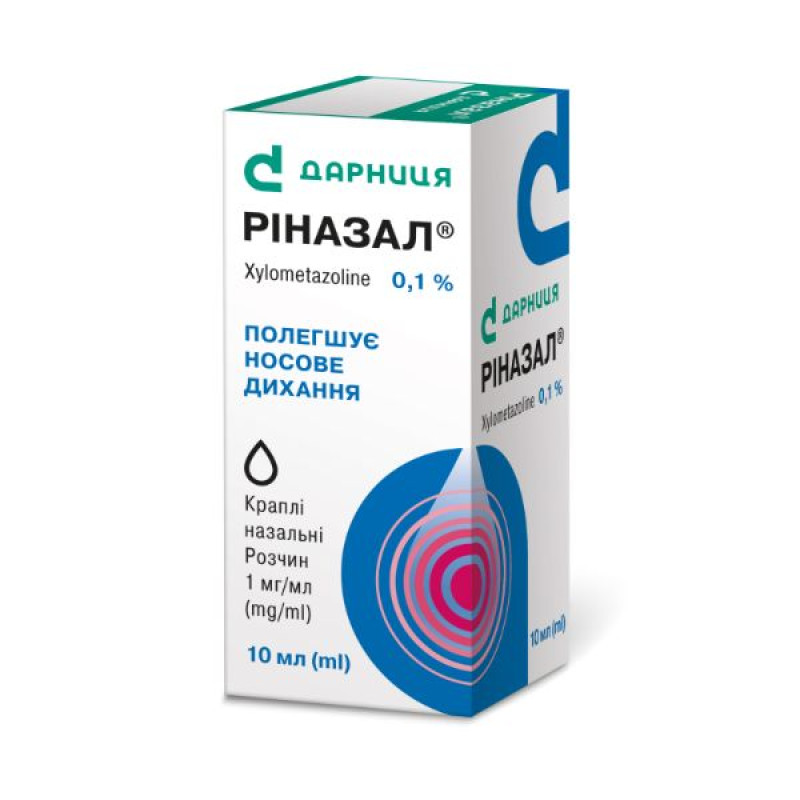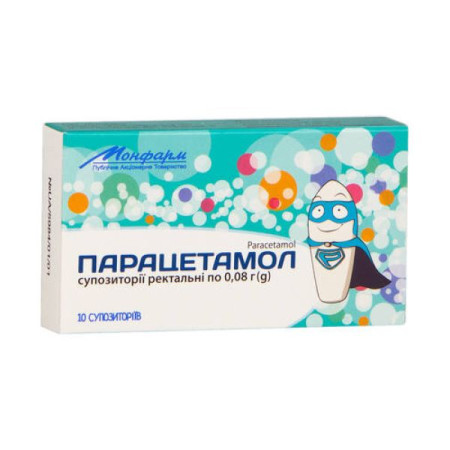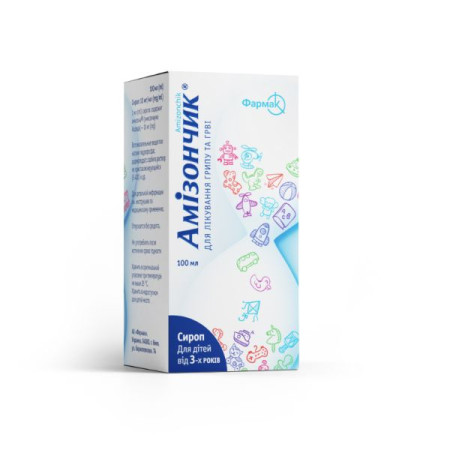Rinazal nasal drops 1 mg/ml bottle 10 ml

Instructions for Rinazal nasal drops 1 mg/ml bottle 10 ml
Composition
active ingredient: xylometazoline;
1 ml of the drug contains xylometazoline hydrochloride 1 mg;
excipients: disodium phosphate dodecahydrate, sodium dihydrogen phosphate dihydrate, sorbitol (E 420), decamethoxine, disodium edetate, purified water.
Dosage form
Nasal drops, solution.
Main physicochemical properties: clear colorless liquid.
Pharmacotherapeutic group
Anti-edematous and other drugs for local use in diseases of the nasal cavity. Sympathomimetics, simple drugs. Xylometazoline. ATX code R01A A07.
Pharmacological properties
Pharmacodynamics
Xylometazoline is an α-adrenomimetic, constricts peripheral vessels. When applied to the nasal mucosa, xylometazoline reduces swelling, reduces hyperemia, exudation, and facilitates nasal breathing.
Pharmacokinetics
The action begins a few minutes after application and lasts up to 12 hours. Long-term use of xylometazoline (more than a week of continuous use) may lead to the development of tachyphylaxis with a decrease in the therapeutic effect. In therapeutic concentrations, xylometazoline does not exhibit systemic action.
Indication
The drug is prescribed for the symptomatic treatment of nasal congestion in colds, hay fever, allergic rhinitis, sinusitis; to facilitate the outflow of secretions in diseases of the paranasal sinuses; as an adjunctive therapy for otitis media (to reduce swelling of the nasal mucosa); to facilitate rhinoscopy.
Contraindication
The drug is contraindicated in case of hypersensitivity to any of its components; in case of dry inflammation of the nasal mucosa, atrophic or vasomotor rhinitis, in case of acute coronary diseases, coronary asthma; in case of hyperthyroidism; in case of angle-closure glaucoma; in case of transsphenoidal hypophysectomy or in case of a history of transnasal/transoral surgical interventions with exposure of the dura mater; in case of concomitant treatment with monoamine oxidase inhibitors (MAOIs) and within 2 weeks after discontinuation of their use.
Interaction with other medicinal products and other types of interactions
MAO inhibitors: xylometazoline should not be used in combination with MAO inhibitors and within 14 days after their discontinuation, as an increase in blood pressure and potentiation of the action of MAO inhibitors is possible.
Local anesthetics: xylometazoline slows the absorption of local anesthetics.
Antidepressants: xylometazoline enhances the effect of antidepressants.
Antihypertensives: xylometazoline may interfere with the action of some antihypertensives, such as β-blockers (may cause bronchospasm or a decrease in blood pressure).
Xylometazoline may enhance the effects of sympathomimetics and reduce the effects of drugs that depress sympathetic nerves.
Application features
The bottle is intended for individual use.
The drug should not be used for a long period of time and the recommended dosage should not be exceeded (especially in children and elderly patients), as this may lead to rhinitis, dry rhinitis, reduced effectiveness of the drug and/or atrophy of the nasal mucosa, provoked by the action of the drug.
The drug should be prescribed with caution to patients who experience severe reactions to adrenergic drugs (insomnia, dizziness, tremor, cardiac arrhythmias, increased blood pressure), and to patients with cardiovascular diseases, diabetes mellitus, thyroid diseases, porphyria, difficulty urinating, prostatic hypertrophy and pheochromocytoma due to a possible sympathomimetic effect.
Due to the vasoconstrictor effect of the drug, an increase in intraocular pressure is possible.
Do not use for longer than 10 days. Prolonged treatment with the drug may cause the opposite effect.
Xylometazoline should be administered with caution to patients with long QT syndrome due to the increased risk of developing serious ventricular arrhythmia.
Important information about excipients.
The medicine contains sorbitol (E 420), so if you have been told by your doctor that you have an intolerance to some sugars, contact your doctor before taking this medicine.
The medicinal product contains sodium, therefore patients on a controlled sodium diet should be careful when using the medicinal product.
Use during pregnancy or breastfeeding
Since the drug has a vasoconstrictor effect, its use during pregnancy is not recommended.
There is no evidence of any adverse effects on the infant. It is not known whether xylometazoline passes into breast milk, therefore use during breastfeeding is not recommended.
Fertility.
There are no adequate data on the effect of the medicinal product on fertility. Since the systemic exposure to xylometazoline hydrochloride is very low, the likelihood of an effect on fertility is extremely low.
Ability to influence reaction speed when driving vehicles or other mechanisms
Usually, the drug has no or minimal effect on the ability to drive or operate other mechanisms (the possibility of dizziness, seizures, and blurred vision should be taken into account).
Method of administration and doses
The bottle is protected by a tamper-evident seal. When using for the first time, the cap must be turned to separate it from the protective ring.
The bottle has a special configuration, thanks to which, when pressed on the bottom, the solution is dosed according to the principle of “one press – one drop”. The hardness of the bottle walls significantly reduces the possibility of a jet release of the drug – the most common cause of an overdose of nasal drops.
Before administering the medication, the nasal cavity should be thoroughly cleaned.
Adults and children over 12 years of age should apply 2–4 drops in each nasal passage 3 times a day.
Apply no more than 3 times a day in each nasal passage (under adult supervision).
The duration of treatment depends on the course of the disease and should not exceed 10 consecutive days.
Children
Xylometazoline nasal drops 0.1% should not be used in children under 12 years of age.
Children should use the medicine under adult supervision.
Overdose
The special configuration of the bottle makes accidental overdose of the drug unlikely. Overdose is possible only if the single doses and frequency of use specified in the instructions are not observed.
Overdose, especially in children, can have significant effects on the central nervous system (CNS), including convulsions, coma, bradycardia, apnea, and increased blood pressure, which is subsequently replaced by a decrease.
When more than 0.2 mg/kg of the drug is administered, symptoms such as increased fatigue, rapid heartbeat and increased blood pressure may occur. In very rare cases, with severe overdose, especially in children (for example, if high doses of the drug are accidentally swallowed), stages of stimulation and depression of the CNS and cardiovascular system may alternate. Symptoms of CNS stimulation may include anxiety, agitation, hallucinations, and in severe cases, convulsions. Symptoms of CNS depression may include a decrease in body temperature, lethargy, drowsiness, and in more severe cases, coma.
Symptoms such as constriction or dilation of the pupils, sweating, pallor, cyanosis, nausea, vomiting, tachycardia, bradycardia, arrhythmia, asystole, decreased blood pressure, circulatory disorders, pulmonary edema, respiratory disorders, ataxia and apnea may also occur.
Treatment of severe overdose (> 1 mg/kg, which for children weighing 20 kg corresponds to the content of 4 vials of the drug) should preferably be started within 1 hour after administration. For the treatment of seizures, use anticonvulsants such as benzodiazepam, for lowering blood pressure - non-selective α-blockers (e.g. doxazosin, terazosin). The use of vasoconstrictors is contraindicated. Atropine should be used only in the case of clinically pronounced bradycardia, accompanied by a decrease in blood pressure.
In case of severe overdose accompanied by cardiac arrest, resuscitation measures should last at least 1 hour.
Adverse reactions
On the part of the organs of vision: transient visual impairment.
Gastrointestinal: nausea, vomiting.
From the nervous system: headache, convulsions, anxiety, increased fatigue (drowsiness, lethargy), hallucinations, dizziness, insomnia; with long-term use of high doses - depression.
From the cardiovascular system: arrhythmia, tachycardia, increased blood pressure.
Immune system, skin and subcutaneous tissue disorders: hypersensitivity reactions, including angioedema, rash, itching, rarely - systemic allergic reactions.
Reactions at the injection site: itching, burning, dryness of the nasopharyngeal mucosa, sneezing, reactive hyperemia, hypersecretion and increased swelling of the nasal mucosa after the drug's effect has decreased, development of secondary rhinitis, nosebleeds.
In some cases, with local intranasal application, a systemic sympathomimetic effect is noted.
If any adverse reactions occur, treatment should be discontinued and a doctor should be consulted.
Reporting of suspected adverse reactions.
Reporting suspected adverse reactions after the marketing authorisation of a medicinal product is an important procedure. It allows for continued monitoring of the benefit-risk balance of the medicinal product in question. Healthcare professionals should report any suspected adverse reactions via the national reporting system.
Expiration date
2 years.
After opening the bottle, the drug should be stored for no more than 28 days.
Storage conditions
Store in original packaging at a temperature not exceeding 15 °C. Do not freeze.
Keep out of reach of children.
Packaging
10 ml in a bottle with a dropper; 1 bottle in a pack.
Vacation category
Without a prescription.
Producer
Location of the manufacturer and address of its place of business
Ukraine, 02093, Kyiv, Boryspilska St., 13.
There are no reviews for this product.
There are no reviews for this product, be the first to leave your review.
No questions about this product, be the first and ask your question.


